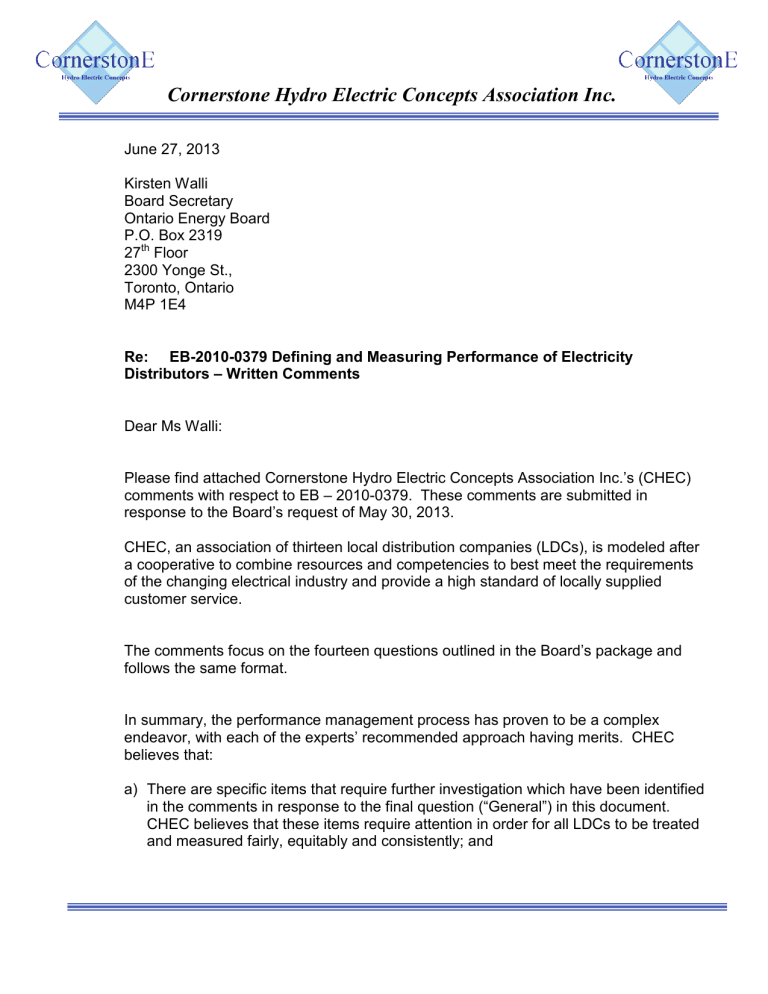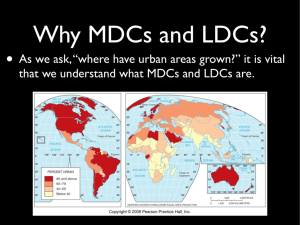Cornerstone Hydro Electric Concepts Association Inc.

Cornerstone Hydro Electric Concepts Association Inc.
June 27, 2013
Kirsten Walli
Board Secretary
Ontario Energy Board
P.O. Box 2319
27 th Floor
2300 Yonge St.,
Toronto, Ontario
M4P 1E4
Re: EB-2010-0379 Defining and Measuring Performance of Electricity
Distributors – Written Comments
Dear Ms Walli:
Please find attached Cornerstone Hydro Electric Concepts Association Inc.’s (CHEC) comments with respect to EB – 2010-0379. These comments are submitted in response to the Board’s request of May 30, 2013.
CHEC, an association of thirteen local distribution companies (LDCs), is modeled after a cooperative to combine resources and competencies to best meet the requirements of the changing electrical industry and provide a high standard of locally supplied customer service.
The comments focus on the fourteen questions outlined in the Board’s package and follows the same format.
In summary, the performance management process has proven to be a complex endeavor, with each of the experts’ recommended approach having merits. CHEC believes that: a) There are specific items that require further investigation which have been identified in the comments in response to the final question (“General”) in this document.
CHEC believes that these items require attention in order for all LDCs to be treated and measured fairly, equitably and consistently; and
b) Rather than implementing one single approach, perhaps there should be a combination or blend that draws out the best of each of the models. For example,
CHEC would like to see Benchmarking based upon Fenrick’s report and the
Productivity drawing upon methodology described in the Yatchew report.
CHEC looks forward to continued engagement in this process.
Yours truly,
Gord Eamer
Gordon A. Eamer, P.Eng.
Chief Operating Officer
43 King St. West
Suite 201
Brockville, ON
K6V 3P7 geamer@checenergy.ca
613-342-3984
CHEC Members
Centre Wellington Hydro
Innisfil Hydro Distribution Systems
Lakeland Power Distribution
Orangeville Hydro
Parry Sound Power
Wasaga Distribution
West Coast Huron Energy
COLLUS Power
Lakefront Utilities
Midland Power Utility
Orillia Power
Rideau St. Lawrence Distribution
Wellington North Power
2
Inflation Factor:
Question 1:
For each expert’s recommended approach (including PEG’s): a. Is the proposed approach appropriate? Does it meet the Board’s policy direction? b. Are the recommended sub-indices appropriate? c. Should the Board be concerned with volatility in the inflation factor?
CHEC Comments:
The inflation factor as presented in the PEG Report is deemed to be too low to accurately reflect sector conditions. The use of the suggested rate would effectively result in a rate freeze of the distribution component which in CHEC’s opinion should not be the desired outcome.
The use of the PEG report and the resulting rates would result in Cost of Service applications with significant rate increases required. During IRMs the rate would not increase at an appropriate rate to track actual costs. Although revenues would be held constant, expenses will have increased resulting in a funding gap. Increases in expenses would be driven by elements such as labour cost, supplier increases, increase of services, fuel increases, property costs and vehicle insurances. These are costs which, in many instances, are not fully under the control of the LDC and even with cost containment would most likely require additional funding. The resulting step increase is not desirable within the supply and costing of energy services.
Question 2:
What is your preferred approach and why?
CHEC Comments:
The proposed method for addressing the inflation factor as outlined in the Fenrick
Report is supported. The use of three factor weighted average growth rates provides a better indication of actual increases in costs.
Use of this method will better track actual increases in cost, helps to mitigate step increases at the time of Cost of Service applications and provides more controlled costing to the customer.
3
Productivity Factor:
Question 3:
For each expert’s recommended approach (including PEG’s): a. Is the proposed approach appropriate? Does it meet the Board’s policy direction noted above? b. Are the recommended inputs and outputs appropriate?
CHEC Comments:
It is quite difficult for CHEC LDCs to comment on the approaches presented as they all represent “expert opinion” although varying opinions.
The PEG Report has noted a productivity factor of 0.1% while the other three expert positions (Fenrick, Yatchew, Cronin) indicate over the regulatory timeframe, a decrease in productivity. This variation and decrease in productivity could be related to the unmeasured outputs as suggested by Dr. Yatchew at the stakeholder conference and confirmed in the PEG Supplementary report.
Further review of the methodologies to move towards a common understanding within the expert positions would appear to be appropriate.
Question 4
What is the appropriate value for an Ontario electricity distribution Total Factor
Productivity trend? Why?
CHEC Comments:
Total Factor Productivity trend which focuses on inputs and outputs has not fully accounted for increased demands placed on the distribution industry. These demands result in additional outputs which may not be fully accounted for in the productivity factors.
Over the past several years the requirement for LDCs to provide more and diverse services to their customers while continuing to modernize the distribution system, have all been addressed by the LDCs. Such initiatives include but are not limited to:
• smart meters;
• time of use;
• MDM/R;
• Conservation and Demand Management;
• LEAP;
• FIT and MicroFIT; and
• International Financial Reporting Standards,
4
These initiatives have been accomplished by LDCs within the scope of system operation and have met customer and government expectations.
The initiatives noted above have not been included in the Total Productivity Factor evaluation and therefore, skews the results of the evaluation. Methodology which accounts for an increase in deliverables should be developed and accounted for within the Total Productivity Factor.
5
Total Cost Benchmarking
Question 5
For each expert’s recommended approach (including PEG’s): a) What do you perceive to be the strengths and weakness of the various consultants’ approaches? b) Are the outputs and recommended business condition variables appropriate?
CHEC Comments:
The Fenrick approach is generally favoured as it would appear to provide more realistic results than the PEG method. While all reports use a number of measures, the measures outlined in the Fenrick report which includes a number of the PEG Report measures may be more appropriate.
Within the scope of the benchmarking questions it would appear there are differences in opinions between the experts which need to be further investigated, by the experts, to finalize a preferred method.
Question 6
What is your preferred approach and why?
CHEC Comments:
While not providing a definitive direction on a preferred approach, as per the above, it is believed that the opinion offered within the Yatchew report with respect to a reward for top tier efficiency may have merit. It would appear that any benchmarking system should include an opportunity for rewards in addition to penalties. As noted in the report such an initiative could help to ensure continued good performance.
Question 7
In PEG’s unit cost/peer group model: a) Are the recommended peer groups appropriate? b) If not, what peer groups would you recommend and why? c) Should each distributor’s unit cost be compared to the average unit cost for the peer group or to the median unit cost for the peer group?
CHEC Comments:
Within the discussions of the expert papers concern is expressed with respect to the ability to define appropriate peer groups and further to assign LDCs accordingly.
Concern exists that the method outlined in the PEG Report would result in faulty groupings. Such issues as “rate application year” or “geographical location” could
6
have impact on measures thereby impacting on appropriate assignment within a peer group. The methodology should be adjusted to account for these factors.
Where a distributor’s unit cost is to be compared with other LDCs, use of the median is preferred. It is felt that use of the median vs. the average will help to buffer impacts of any outliers, such as Algoma, which could have significant impact on the averages.
7
LV and HV Services
Question 8
In general, is the approach to dealing with differences in HV & LV services modeled by
PEG appropriate?
CHEC Comments:
A normalized process as suggested within the PEG Report is supported. Currently however the process suggested is cumbersome and believed to require additional work to ensure accuracy. Such items as Monthly Service charge and Common ST
Line charges, should be removed to better reflect real costs.
Low Voltage Charges
Question 9. a
Which of the following LV-related charges should be included in total cost benchmarking? If you recommend excluding a charge, please explain. (list as per request letter)
CHEC Comments:
Within the scope of the low voltage charges it is suggested that only the Specific LV
Line and Specific ST Line be included in the charges. All others should be removed as they form part of a common element across all LDCs which may not be appropriately distributed to individual LDCs.
The pooling of the LV system is to provide a system advantage (only one system constructed) which benefits all customers. LDCs had not considered the impact of LV construction on cost to their customers and as such the industry and regulations, at the time of construction, did not offer alternatives to the construction. Further the premise for construction was to provide service to all portions of the province and to pool certain costs. To extract these costs at this time, other than specific costs, is not consistent to the process in place for constructing the LV system.
In the past LV charges were regarded as pass through charges as LDCs did not exert any control over these charges. Moving forward, if the inclusion of LV system costs are deemed appropriate LDCs must have additional opportunity for input and to evaluate alternatives, as there will be a direct relationship to the cost assigned to their
LDCs. Further a more competitive approach to constructing the LV system may be required to allow LDCs or groups of LDCs to construct LV system, to the same standards, but at reduced cost than perhaps is being proposed by the transmission company.
8
With respect to particular charges the following is suggested:
I. Common ST Lines should be removed as the method for assigning costs does not represent equity between users. For example if Hydro One constructs a 5 km line to service a 100 kW customer and the line continues a further 1 km to serve an LDC with a peak demand of 900 kW, the result could be the LDC pays
90% of the line if costs are assigned on connected peak. In reality Hydro One was required to build the line for the initial customer and hence should bear more of the costs. If common ST Lines are to remain, appropriate cost assignment needs to be developed.
II. LV switching charges are received by LDCs where load is transferred between different Hydro One Transformer Stations. The peak load is applied to two different billing points and charged to the LDC, effectively doubling the cost, which can be material. The LDC is not in control of the switching operation
(which is normally done by Hydro One to accommodate maintenance & repairs) and does not apply any real costs to the LV System. As such LV Switching charges should not be included in the LDC’s OM&A and any evaluations comparing LDC costs.
III. Monthly Service Charges should be removed as these charges reflect the fixed costs relating to not only LV, but other Hydro One costs including transmission connection, transmission network, global adjustment, etc. The Monthly Service charges are not specifically related to LV costs
IV. Should the Board determine the Monthly Service charges and the Common ST
Lines are to be included, CHEC would request all LDCs be treated equitably – i.e. even if an LDC does not have Common ST Lines or LVDS Charges, they will have the Monthly Service Charge. This charge should appear on all LDCs from the Hydro One data set.
V. Chec would further request that any Common ST Line charges that relate to sub transmission outside the respective territory be removed. Hydro One has indicated that it would have to perform this on an individual LDC basis. It is
CHEC’s view that the Board initiates a consultation to determine what low voltage charges are specific to each LDC. This will alleviate the necessity of pooling of costs and charging these costs back to the LDCs based on demand.
LDCs need to be involved in this process to consider and verify the costs to their distribution system.
VI. LV charges is an area that requires attention in terms of ensuring the accuracy of these charges compiled by Hydro One when billing LDCs. If LV charges are included then LDCs must be provided the opportunity to; fully understand the costs, how they are being determined, division of costs between LDC LV systems and Hydro One LV system and to affect and control these costs. All of
9
the Hydro One LV costs, which account for a significant component of LDC costs, needs to be investigated. It is recommended that a consultation be initiated by the Board to address these steadily increasing costs.
Question 9b
9. b. The Performance and Benchmarking Working Group raised concern that in circumstances where a shared LV line spans sparsely populated areas of Hydro One’s service area, the inclusion of 100% of the “Shared LV Line” costs in the embedded distributor’s benchmarking costs may unfairly overstate the LV costs for that distributor.
How might the Board identify these circumstances and only allocate “Shared LV Line” costs in proportion to the “Shared LV Line” that is in the embedded distributor’s service territory?
CHEC Comments:
This is recognized as an issue. As noted above only Specific LV Line and Specific ST
Line charges should be considered for inclusion. If additional charges are to be considered for inclusion as noted in comments to question 9.a it is suggested that the
OEB initiate a consultation on Low Voltage charges to ensure the costs are being equitably shared across the host(s) and embedded LDCs.
10
Efficiency Cohorts/Ranking & Stretch Factors
Question 10
For each expert’s recommended approach: a) Is the proposed approach appropriate? Does it meet the Board’s policy direction noted above? b) What is your preferred approach and why?
CHEC Comments:
The PEG Report utilizes a deemed capital method which groups all capital assets together and assumes the same lifetime for all assets. In reality system equipment and more specifically transformers have a lifetime in excess of the lifetime utilized in the deemed method. It is believed the deemed method is too general when applied to the capital assets.
The method as outlined in the Yatchew report is generally more acceptable and the associated recommendations should be considered further for application. For example, the Yatchew report correctly considers rewarding LDCs for positive performance.
Question 11
What are appropriate stretch factor values? Why?
CHEC Comments:
Based on the papers presented the -0.3% to 0.3% as presented in the Yatchew Report is the recommended approach. These values are supported based on the discussion presented in the report.
11
Implementation Considerations
Question 12
What indicators should the Board consider monitoring on an on-going basis to test the reasonableness of the results of its PCI formula before it is applied to adjust the distributor’s rates (i.e., ex ante)?
CHEC Comments:
It is suggested that general interest rates and cost of living measures should apply.
These measures not only represent the overall business and societal measures but also form a basis on which customers are familiar with. In today’s environment a 1% to
2% annual increase helps to maintain a consistent rate pattern and provides a baseline for growth. Applied to LDCs with low growth, this level of interest rate and cost of living helps to provide stability to the LDC and to the customer.
Further if inflation is not reasonably set an LDC may not achieve any rate increase through the IRM process which would result in a significant rate increase request at the time of Cost of Service. In the IRM years, with an inappropriate inflation rate, the LDC may be effectively in a rate freeze pending a Cost of Service. This can impact on the ability of the LDC to best meet the needs of its customers and also in a step rate increase for the customer.
The stretch factor is taking into account productivity to be gained by the LDCs. If inflation is not set appropriately, LDCs will be penalized not only by the stretch factor, but by an inflationary decrease.
Question 13
When the Board updates the industry productivity factor every five years, should the new productivity factor be automatically applied to all distributors that are then on 4th
Generation IR? Why or why not?
CHEC Comments:
The productivity factor should be applied to all LDCs except those LDCs filing a Cost of
Service application as specific data will be provided on which to make assessments.
Applying the same factor will provide consistency across the sector.
Within the Expert Reports it would appear there is some disagreement on the level of productivity within the sector. If the industry has experienced negative productivity for at least the last ten years we believe the calculation of the productivity factor must be missing important elements. All of the mandated policies and programs, over the past ten years, need to be identified and correctly included in the measurements. Such initiatives as: smart meters, Conservation and Demand Management, Green Energy
Act etc. all impact on productivity measures. These elements need to be identified,
12
analyzed and included in the measurement of productivity if the productivity factor is to be effectively and properly utilized.
13
General
Question 14:
With respect to your preferred approaches, as identified in your answers to prior questions, what other implementation matters, if any, need to be considered by the
Board?
CHEC Comments:
In concluding, CHEC would like the Board to explore the following points: a) The PEG Report data has errors in it which need to be corrected. When the
2012 data is utilized LDCs should be provided the data set for review to ensure the appropriate numbers have been utilized. It is very important for LDCs to have the opportunity to review the base data. b) If LV charges are to be applied, the process needs to ensure that the charges are consistently applied to all LDCs. c) The 2012 data will have OM&A included for the years 2006 through to 2011 as well as 2012 relating to the cost of the smart meters initiative. This is due to the prudence review completed in 2012 by many LDCs. Consequently, the 2012
OM&A is not reflective of the actual 2012 costs as it includes 2006 to 2011 smart meter OM&A costs.
Therefore, the smart meter OM&A data needs to be normalized for consideration. Reflecting the costs in the year incurred may be appropriate. d) At the Stakeholder Conference it was noted by Steven Fenrick that smaller
LDCs will be disadvantaged by the approaches used in the PEG Report. This comment needs to be explored further by the Board to determine the magnitude of such a disadvantage and to adjust the process accordingly to ensure that small LDCs are not disadvantaged by the process. e) When Benchmarking LDC OM& A expenses, there should be a method to show a “Normal” year of costs incurred (i.e. how much does it cost to run a LDC that excludes any non-annual or bespoke costs). By removing “extraordinary or bespoke costs” (i.e. those costs that are a one-off or occur in varying years, such as in a Cost of Service rate application year), it would be a more consistent approach in measuring the true performance of an LDC and comparing it to others. f) Concern is raised with the consideration that the maximum stretch factor will be utilized for an LDC when doing an IRM. The evaluation and assignment of stretch factors is completed to determine how well an LDC is performing and to
14
provide a stretch factor on that basis. The proposed application of the maximum stretch factor in IRM years does not recognize the identified performance of the LDC. It is recommended that stretch factors be evaluated and assigned on a regular basis and that the stretch factor be utilized for IRM years, whether the LDC is under the 4 th or 3 rd Generation IRM regime. A method should also be available for LDCs to request a re-evaluation of stretch factor to allow the LDC to move from one group to another between schedule re-assessments. g) The performance management process has proven to be a complex endeavour.
As such once implemented process issues may be determined that are detrimental to one or more groups of LDCs. Where these issues are material, a process for addressing these issues should be incorporated into the Board processes to allow timely resolution.
15




